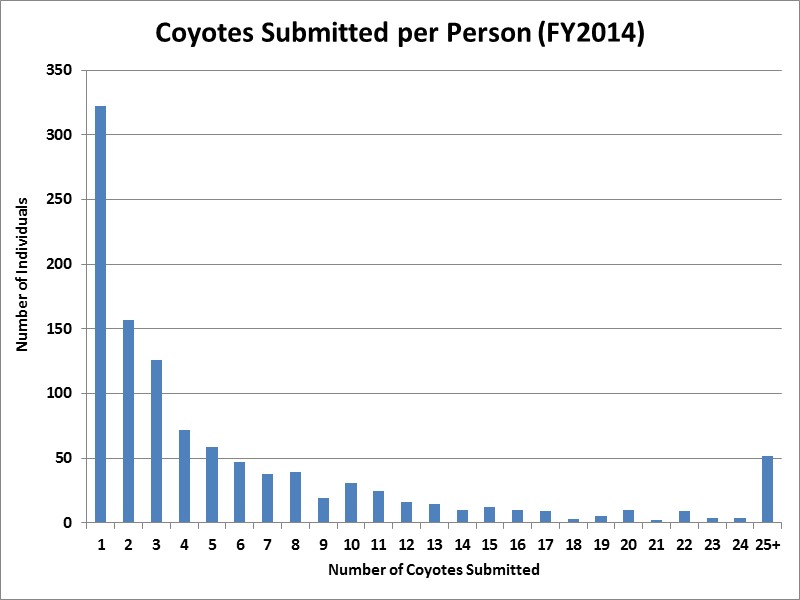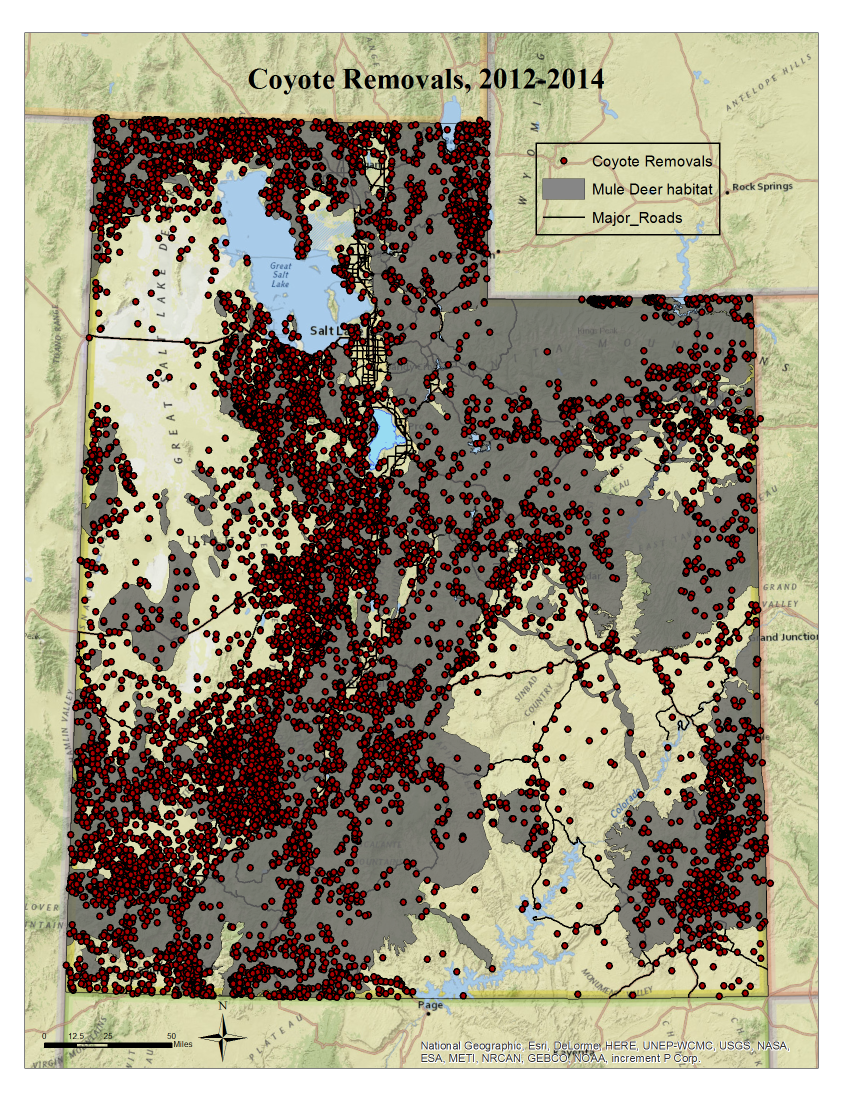Fiscal Highlights 2014
|
Coyote Removal Program -
Ivan D. Djambov ( The Division of Wildlife Resources (DWR) has been working to improve the mule deer numbers in Utah for several years (see chart below). In addition to DWR's efforts to improve the trend by restoring deer habitat, reducing highway mortality, and limiting spread of disease, in the last two years, the division has increased their efforts in predator control.
UCA 23-30-104 authorizes the division to provide incentives to participants who "remove a predatory animal that is detrimental to mule deer production." Two years ago, DWR implemented a coyote removal program with a $50 bounty. To receive the reward, each participant must submit the scalp of the coyote with both ears attached, the lower jaw, and a datasheet that documents where it was killed. The division has been using the $500,000 annual appropriation from the Mule Deer Protection Account for the program. $352,100 of the total FY 2014 appropriation was used to pay the $50 for 7,041 submitted coyotes to 1,096 individuals. The figure below shows the number of coyotes submitted by person. Two-thirds of the participants submitted five animals or less. $140,000 of the remaining funding was used for 14 contracts with individuals for coyote removal in specific areas. The contractors removed total of 236 coyotes in FY 2014. The average cost per removed coyote is $593. One half of the submitted coyotes in FY 2014 were taken in six deer management units: Box Elder, West Desert, SW Desert, Fillmore, Beaver, and Pine Valley. Are coyotes killed where there is a need or where it is convenient? The answer from DWR is: yes to both. The figure below provides a map with the location the coyotes were taken (red dots), and an overlaid map of the mule deer range in Utah (shaded dark gray) for the period 2012-2014. Ideally, all of the coyote harvests should occur within the grey areas, which would benefit mule deer.
In addition to predator location, important factors impacting the mule deer population are the time of year the coyotes are taken, as well as the age and gender of the removed coyotes. The program currently does not restrict or discriminate among those factors. The reward is provided per killed coyote. In the future, as they collect more data on the coyote and deer populations, DWR biologists may want to consider adjusting the rules to include these factors to increase the efficiency and effectiveness of the program. |
Coyote Removal Program - Ivan D. Djambov The Division of Wildlife Resources (DWR) has been working to improve the mule deer numbers in Utah ...DAS and DTS Reports - Gary K. Ricks In the last few months, the Departments Technology Services and Administrative Services and ha...How Close Did We Come to the Cap on Sales Tax Earmarks for Transportation in FY 2014? - Steven M. Allred Since 2005, the Legislature has earmarked portions of the sales tax for highway construction projec...How Have Tax Changes in Utah Compared to the Nation? - Thomas E. Young Every spring and winter, the National Association of State Budget Officers (NASBO) releases numbers...Income Tax Appropriations to Public and Higher Education - Ben Leishman In November 1996, Utah voters amended the Utah Constitution to formally authorize the pra...Pew Final Key Findings - Gary R. Syphus After several months of research, the Pew Charitable Trusts' Public Safety Performance Project ...Snow College Concurrent Enrollment Update - Spencer C. Pratt During the 2014 General Session, the Legislature passed S.B. 38, "Snow College C...The Changing Demographics of Expected Income - Angela J. Oh The two recent recessions and subsequent recoveries continue to affect expected lifetime income by ...Utah's Credit Rating and Debt Measures - Brian Wikle Did you know the State of Utah has a credit score? Although the stat...Utah's Revenue Continues to Grow - Andrea Wilko Utah ended FY 2014 with a $166 million General and Education Fund revenue surplus. The revenu... |
Reports/Archive | Budget Process | Office Background | Who's Who | Organization Chart
Office of the Legislative
Fiscal Analyst
House Building, Suite W310
Salt Lake City, UT 84114
Phone (801) 538-1034 Fax (801) 538-1692



